MARKETING
7 Tips to Highlight Product Features on Your Website

Whether your customers are shopping for tennis shoes or a marketing automation tool, they care about your product’s features. Features (along with price and design) are one of the main factors people consider when comparing products.
Would you buy a computer without knowing how much storage it has? Or a pair of yoga pants without knowing whether they stretch?
Despite their importance, many brands fail to make their product’s features clear on their websites—and that could cause revenue to drop.
Your product’s features are massive selling points, so they need to be clear and compelling. Here’s how to get your product features right.
What Is a Product Feature?
A product feature is a characteristic of your product that differentiates it from other products in the market. It could be how it looks (a design feature), how you can use it (a functional feature) or what it comes with (an added-value feature).
Let’s take running shoes as an example. The material of the shoe is a feature, so is the technology in the shoe. Both are highlighted in this example by Nike.
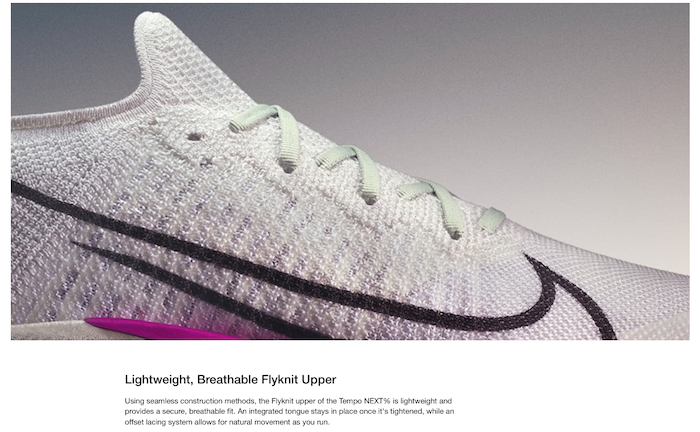
What about a software product?
Features typically center on the product’s functionality (what you can do with it), but they can also include integrations or data security. Slack’s feature page below highlights these types of features:
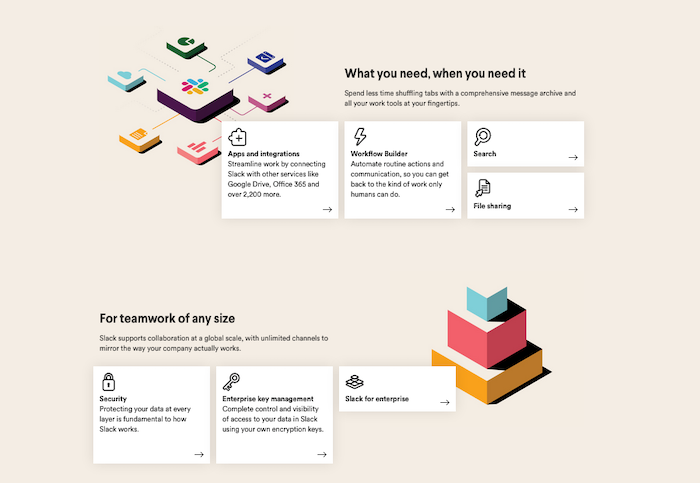
Features don’t have to be unique to your product, though. As design, technology, and manufacturing processes evolve, some features become standard. You’d be hard-pressed to buy a smartphone without a touchscreen, but that doesn’t mean it isn’t a feature brands can talk about.
Whether your product comes with ten features or two, you need to be talking about them across your website including your product descriptions, landing page, and even your homepage.
Make your product features clear so customers can easily compare you to your competitors. It’s even more important if your product boasts the best features in the industry. The more you shout about them, the more likely consumers are to take notice—and maybe make a purchase.
7 Strategies for Highlighting Product Features
You know what features are, and you know why they’re important to include on your site. Now let’s look at seven ways e-commerce stores and SaaS tools can effectively leverage them.
Include Social Proof
Talking about how great your features are is nice, but every other company does the same thing. Even if your product features are superior, customers may not believe you. After all, only one-third of customers trust the brands they buy from.
You need social proof to convince them your product delivers. Add quotes and testimonials from your customers or trusted third parties that mention your product features to relevant pages. Better yet, include images and videos of them using your product.
Featuring real people showing off your product’s features instantly makes them more credible and makes it much more likely consumers will trust your brand.
UK maternity brand Isabella Oliver does a great job of this, including a quote from Vogue in the product description of a maternity tank dress.
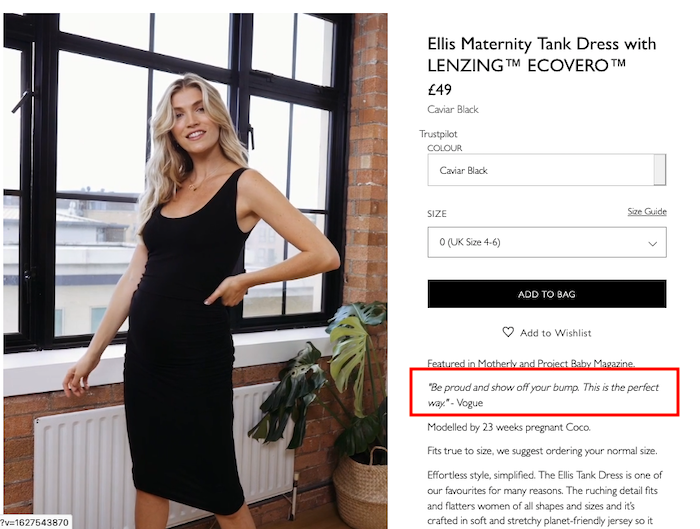
Speak to Your Target Audience
You need to understand your target audience to write about your product features effectively. If you have buyer personas, make sure to refer to them while writing. This will help you prioritize which features your customers care about most.
Start by looking at reviews for your product and those of your competitors—G2 is a great place to start for software companies and Amazon for e-commerce brands. Identify the top features customers talk about and prioritize them.
Be wary of trying to target everyone. This is particularly important for SaaS products that can have a dozen different use cases. Each target customer should have a dedicated landing page where you speak exclusively about relevant product features. If you try to speak to everyone on one landing page, you’ll end up not targeting any audience well.
Everlane is an example of a brand who knows their target audience and what they care about. Each product description includes a link to the factory it’s made in and other information related to sustainability.

Focus on the Benefits
Consumers only care so much about what makes your product special. What they really care about is how it benefits them.
Talk about a benefit whenever you mention a feature.
Writing about benefits requires a bit more effort and creativity. Your product’s features are fairly obvious, especially to you. What isn’t so obvious is how the user benefits from them. Think about your customer personas and spend some time reading product reviews. These will help you get into your customers’ minds and focus on the benefits they care about.
If you really want to do a good job, interview your customers to find out exactly how they benefit from your product. It takes a little more effort, but this is hands-down the best way to tease out the benefits of your product.
One of Hootsuite’s most popular features is the ability to track social media mentions on their dashboard–but that’s not how the brand sells the feature to its users. Instead, they focus on the benefit: finding out what customers really think. They even follow this up with another user-generated benefit of the feature.
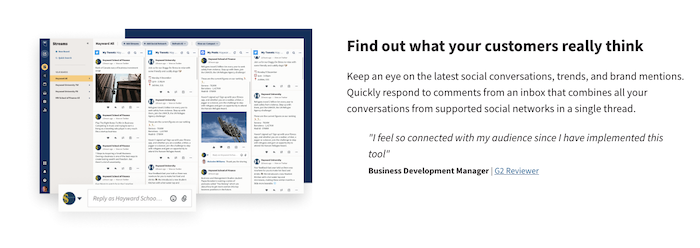
Draw Attention to the Important Details
There are some features you’ll want customers to take note of more than others. That’s why it’s important to create a hierarchy of features and look for ways to draw attention to the features consumers care most about.
To do this, break your page into sections and devote each section to a specific feature. Use a bold heading to grab your reader’s attention and back this up with short, sharp copy and eye-catching imagery.
Google takes this to the extreme by letting each feature take up all of the screen’s real estate. There’s no way to miss them:

Another is to remove the navigation menu from your landing page. With no way to move away from the page, users are forced to focus on your sales copy and read about your product’s features. Don’t get carried away using this tactic, however. Most customers won’t be happy with you removing the navigation bar, especially if you’re an e-commerce site.
Make Information Scannable
Your customers are busy, and most aren’t going to read every word on your page. Instead, they’re going to scan it for key bits of information. It’s your job to make your product features as scannable as possible while still getting across the core message.
Bullet points are an excellent tool because huge chunks of text are a massive turn-off for readers—especially if you want to share a lot of information.
Target includes a bullet list of each product’s features on their listing page, so you don’t even have to click them individually to get the need-to-know information.
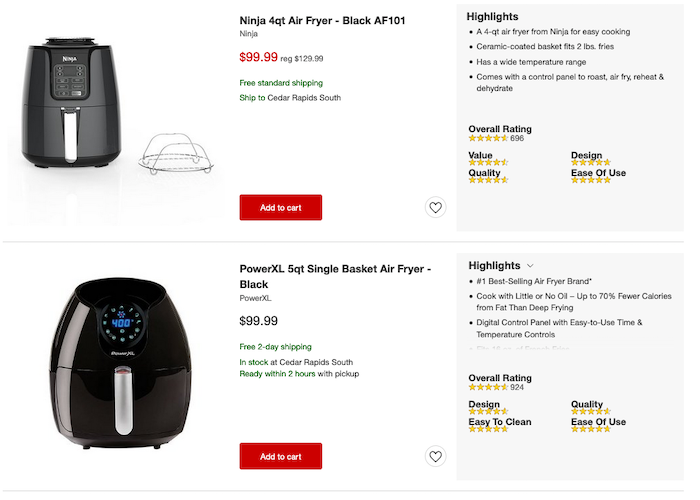
Use Video and Images
Words aren’t the only way to get across your product features. Images and videos are usually a much better way to get across exactly what your product can do.
Images are an easy way to show customers how key features look and work. They are particularly powerful for design-focused features and most e-commerce products in general. Bonus points if you include user-generated photos in your descriptions.
UK furniture brand Made did a great job of including user-generated images in their product listings. Potential customers can see exactly what each sofa will look like in a range of settings.

Videos take a little more work, but they can be even more effective. For example, you could create an explainer video that highlights your product’s core features, or a separate video for each feature.
Your feature-led videos can also be used as part of your onboarding process and by your sales team during client calls. They can even boost your search rankings, especially if you host them on YouTube.
Write Blog Posts and Emails
If you have a SaaS product, blog posts, emails, and other forms of content marketing are one of the best ways to highlight your product features—particularly if those features come in the form of new software releases.
Make sure your blog posts talk about the benefits that users can gain from the new features and don’t just talk about the features alone. Plenty of screenshots are also a good idea, so is a video if you can create one.
Unlike other forms of content marketing, there’s no need to post these articles regularly. Writing them when you have a new feature to describe is enough.
Email updates should also be sent sparingly. Only email when you have a new feature to announce and keep your email succinct. Only include the key details in the email and link to a more in-depth blog post if necessary.
Existing users will learn about the new features when using the software, so it may be wise to only send an email about features that may re-engage lost customers.
Asana’s blog is filled with feature-focused blog posts. Note that many don’t focus on individual features. Rather they cluster feature releases around a particular topic and write about that instead.
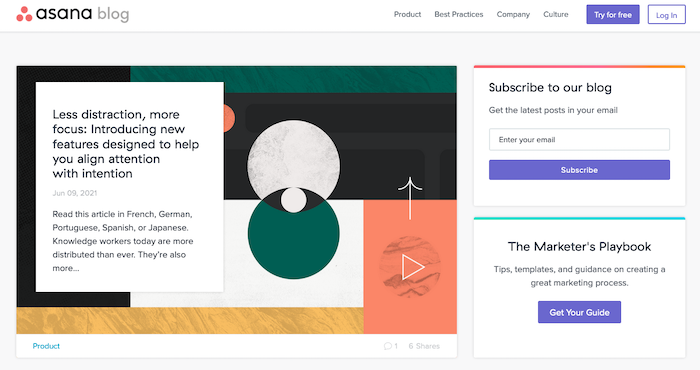
3 Examples of Product Feature Highlights
If the examples above weren’t enough for you, I’ve got three more examples of brands that do a great job highlighting their product features.
Apple

Few companies are better than Apple at creating buzz about their products. There aren’t many better at highlighting their product’s benefits, either.
Apple makes a point of creating a new banner for every feature, pairs each with a user benefit, and includes high-quality images and graphics. Even if you already have an iPhone, reading their product pages makes you want to upgrade.
Amazon
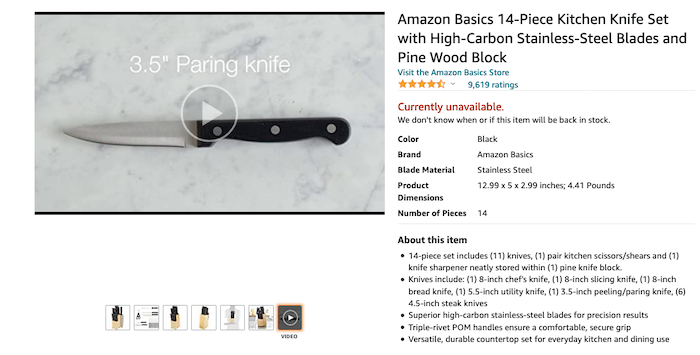
Amazon is famous for its in-depth product listings, but those listings are also great at highlighting each product’s most important features.
The clear layout makes it easy for customers to skim the product description, and bullet points highlight the most important features. There’s even a video showcasing the product in detail.
Tesla
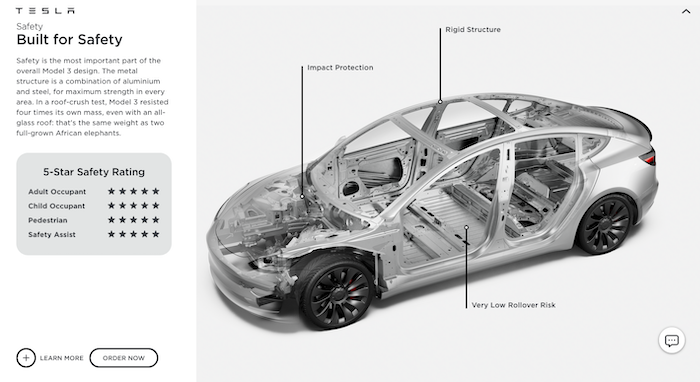
Tesla combines several of the tactics mentioned above to highlight the key features of the Model 3. Each feature is given a hierarchy—security is first—and takes up the entire page. They also use graphics to illustrate points and annotations to draw attention to specific features.
Frequently Asked Questions About Product Features
What are product features?
Your product features are any characteristic of your product that makes it stand out and separates it from your competitors. It can include the look and design of the product, how it’s made, or what you can do with it.
What are examples of product features?
For an e-commerce product, the material the product is made with can be a feature—if it’s made from recycled plastic, for example. For SaaS products, features include the functionality of the product. The ability to instantly message colleagues is a feature of Slack, for instance.
What’s the difference between a product feature and a benefit?
A feature is a characteristic of your product. A benefit is how a customer can use that characteristic to overcome a pain point.
How can I highlight the features of my SaaS product?
A sales page is an excellent way to highlight all of the features of your SaaS products. Blog posts, videos, and demos are also great ways to highlight SaaS features.
How can I highlight the features of my e-commerce product?
Your product description is the best place to highlight the features of your e-commerce product. Make sure they are easy to read and stand out from the rest of your copy.
The Conclusion of My Product Features Guide
Showcasing your product features is a hugely underrated tactic. Marketers and salespeople will tell you to focus on the benefits of your product rather than the features. While benefits are important, they rely on explaining your features clearly first. Features are also one of the most common ways potential customers compare your product with your competitors.
Take time to determine which features are most important and get opinions from current customers if you can. Then use the seven tactics I’ve listed above to make them as clear as possible on your site.
Which features of your product are you most proud of?
See How My Agency Can Drive Massive Amounts of Traffic to Your Website
- SEO – unlock massive amounts of SEO traffic. See real results.
- Content Marketing – our team creates epic content that will get shared, get links, and attract traffic.
- Paid Media – effective paid strategies with clear ROI.
MARKETING
Tinuiti Marketing Analytics Recognized by Forrester

Rapid Media Mix Modeling and Proprietary Tech Transform Brand Performance
Tinuiti, the largest independent full-funnel performance marketing agency, has been included in a recent Forrester Research report titled, “The Marketing Analytics Landscape, Q2 2024.” This report comprehensively overviews marketing analytics markets, use cases, and capabilities. B2C marketing leaders can use this research by Principal Analyst Tina Moffett to understand the intersection of marketing analytics capabilities and use cases to determine the vendor or service provider best positioned for their analytics and insights needs. Moffett describes the top marketing analytics markets as advertising agencies, marketing dashboards and business intelligence tools, marketing measurement and optimization platforms and service providers, and media analytics tools.
As an advertising agency, we believe Tinuiti is uniquely positioned to manage advertising campaigns for brands including buying, targeting, and measurement. Our proprietary measurement technology, Bliss Point by Tinuiti, allows us to measure the optimal level of investment to maximize impact and efficiency. According to the Forrester report, “only 30% of B2C marketing decision-makers say their organization uses marketing or media mix modeling (MMM),” so having a partner that knows, embraces, and utilizes MMM is important. As Tina astutely explains, data-driven agencies have amplified their marketing analytics competencies with data science expertise; and proprietary tools; and tailored their marketing analytics techniques based on industry, business, and data challenges.
Our Rapid Media Mix Modeling sets a new standard in the market with its exceptional speed, precision, and transparency. Our patented tech includes Rapid Media Mix Modeling, Always-on Incrementality, Brand Equity, Creative Insights, and Forecasting – it will get you to your Marketing Bliss Point in each channel, across your entire media mix, and your overall brand performance.
As a marketing leader you may ask yourself:
- How much of our marketing budget should we allocate to driving store traffic versus e-commerce traffic?
- How should we allocate our budget by channel to generate the most traffic and revenue possible?
- How many customers did we acquire in a specific region with our media spend?
- What is the impact of seasonality on our media mix?
- How should we adjust our budget accordingly?
- What is the optimal marketing channel mix to maximize brand awareness?
These are just a few of the questions that Bliss Point by Tinuiti can help you answer.
Learn more about our customer-obsessed, product-enabled, and fully integrated approach and how we’ve helped fuel full-funnel outcomes for the world’s most digital-forward brands like Poppi & Toms.
The Landscape report is available online to Forrester customers or for purchase here.
MARKETING
Ecommerce evolution: Blurring the lines between B2B and B2C

Understanding convergence
B2B and B2C ecommerce are two distinct models of online selling. B2B ecommerce is between businesses, such as wholesalers, distributors, and manufacturers. B2C ecommerce refers to transactions between businesses like retailers and consumer brands, directly to individual shoppers.
However, in recent years, the boundaries between these two models have started to fade. This is known as the convergence between B2B and B2C ecommerce and how they are becoming more similar and integrated.
Source: White Paper: The evolution of the B2B Consumer Buyer (ClientPoint, Jan 2024)
What’s driving this change?
Ever increasing customer expectations
Customers today expect the same level of convenience, speed, and personalization in their B2B transactions as they do in their B2C interactions. B2B buyers are increasingly influenced by their B2C experiences. They want research, compare, and purchase products online, seamlessly transitioning between devices and channels. They also prefer to research and purchase online, using multiple devices and channels.
Forrester, 68% of buyers prefer to research on their own, online . Customers today expect the same level of convenience, speed, and personalization in their B2B transactions as they do in their B2C interactions. B2B buyers are increasingly influenced by their B2C experiences. They want research, compare, and purchase products online, seamlessly transitioning between devices and channels. They also prefer to research and purchase online, using multiple devices and channels
Technology and omnichannel strategies
Technology enables B2B and B2C ecommerce platforms to offer more features and functionalities, such as mobile optimization, chatbots, AI, and augmented reality. Omnichannel strategies allow B2B and B2C ecommerce businesses to provide a seamless and consistent customer experience across different touchpoints, such as websites, social media, email, and physical stores.
However, with every great leap forward comes its own set of challenges. The convergence of B2B and B2C markets means increased competition. Businesses now not only have to compete with their traditional rivals, but also with new entrants and disruptors from different sectors. For example, Amazon Business, a B2B ecommerce platform, has become a major threat to many B2B ecommerce businesses, as it offers a wide range of products, low prices, and fast delivery
“Amazon Business has proven that B2B ecommerce can leverage popular B2C-like functionality” argues Joe Albrecht, CEO / Managing Partner, Xngage. . With features like Subscribe-and-Save (auto-replenishment), one-click buying, and curated assortments by job role or work location, they make it easy for B2B buyers to go to their website and never leave. Plus, with exceptional customer service and promotional incentives like Amazon Business Prime Days, they have created a reinforcing loyalty loop.
And yet, according to Barron’s, Amazon Business is only expected to capture 1.5% of the $5.7 Trillion addressable business market by 2025. If other B2B companies can truly become digital-first organizations, they can compete and win in this fragmented space, too.”
If other B2B companies can truly become digital-first organizations, they can also compete and win in this fragmented space
Joe AlbrechtCEO/Managing Partner, XNGAGE
Increasing complexity
Another challenge is the increased complexity and cost of managing a converging ecommerce business. Businesses have to deal with different customer segments, requirements, and expectations, which may require different strategies, processes, and systems. For instance, B2B ecommerce businesses may have to handle more complex transactions, such as bulk orders, contract negotiations, and invoicing, while B2C ecommerce businesses may have to handle more customer service, returns, and loyalty programs. Moreover, B2B and B2C ecommerce businesses must invest in technology and infrastructure to support their convergence efforts, which may increase their operational and maintenance costs.
How to win
Here are a few ways companies can get ahead of the game:
Adopt B2C-like features in B2B platforms
User-friendly design, easy navigation, product reviews, personalization, recommendations, and ratings can help B2B ecommerce businesses to attract and retain more customers, as well as to increase their conversion and retention rates.
According to McKinsey, ecommerce businesses that offer B2C-like features like personalization can increase their revenues by 15% and reduce their costs by 20%. You can do this through personalization of your website with tools like Product Recommendations that help suggest related products to increase sales.
Focus on personalization and customer experience
B2B and B2C ecommerce businesses need to understand their customers’ needs, preferences, and behaviors, and tailor their offerings and interactions accordingly. Personalization and customer experience can help B2B and B2C ecommerce businesses to increase customer satisfaction, loyalty, and advocacy, as well as to improve their brand reputation and competitive advantage. According to a Salesforce report, 88% of customers say that the experience a company provides is as important as its products or services.
Market based on customer insights
Data and analytics can help B2B and B2C ecommerce businesses to gain insights into their customers, markets, competitors, and performance, and to optimize their strategies and operations accordingly. Data and analytics can also help B2B and B2C ecommerce businesses to identify new opportunities, trends, and innovations, and to anticipate and respond to customer needs and expectations. According to McKinsey, data-driven organizations are 23 times more likely to acquire customers, six times more likely to retain customers, and 19 times more likely to be profitable.
What’s next?
The convergence of B2B and B2C ecommerce is not a temporary phenomenon, but a long-term trend that will continue to shape the future of ecommerce. According to Statista, the global B2B ecommerce market is expected to reach $20.9 trillion by 2027, surpassing the B2C ecommerce market, which is expected to reach $10.5 trillion by 2027. Moreover, the report predicts that the convergence of B2B and B2C ecommerce will create new business models, such as B2B2C, B2A (business to anyone), and C2B (consumer to business).
Therefore, B2B and B2C ecommerce businesses need to prepare for the converging ecommerce landscape and take advantage of the opportunities and challenges it presents. Here are some recommendations for B2B and B2C ecommerce businesses to navigate the converging landscape:
- Conduct a thorough analysis of your customers, competitors, and market, and identify the gaps and opportunities for convergence.
- Develop a clear vision and strategy for convergence, and align your goals, objectives, and metrics with it.
- Invest in technology and infrastructure that can support your convergence efforts, such as cloud, mobile, AI, and omnichannel platforms.
- Implement B2C-like features in your B2B platforms, and vice versa, to enhance your customer experience and satisfaction.
- Personalize your offerings and interactions with your customers, and provide them with relevant and valuable content and solutions.
- Leverage data and analytics to optimize your performance and decision making, and to innovate and differentiate your business.
- Collaborate and partner with other B2B and B2C ecommerce businesses, as well as with other stakeholders, such as suppliers, distributors, and customers, to create value and synergy.
- Monitor and evaluate your convergence efforts, and adapt and improve them as needed.
By following these recommendations, B2B and B2C ecommerce businesses can bridge the gap between their models and create a more integrated and seamless ecommerce experience for their customers and themselves.
MARKETING
Streamlining Processes for Increased Efficiency and Results

How can businesses succeed nowadays when technology rules? With competition getting tougher and customers changing their preferences often, it’s a challenge. But using marketing automation can help make things easier and get better results. And in the future, it’s going to be even more important for all kinds of businesses.
So, let’s discuss how businesses can leverage marketing automation to stay ahead and thrive.
Benefits of automation marketing automation to boost your efforts
First, let’s explore the benefits of marketing automation to supercharge your efforts:
Marketing automation simplifies repetitive tasks, saving time and effort.
With automated workflows, processes become more efficient, leading to better productivity. For instance, automation not only streamlines tasks like email campaigns but also optimizes website speed, ensuring a seamless user experience. A faster website not only enhances customer satisfaction but also positively impacts search engine rankings, driving more organic traffic and ultimately boosting conversions.
Automation allows for precise targeting, reaching the right audience with personalized messages.
With automated workflows, processes become more efficient, leading to better productivity. A great example of automated workflow is Pipedrive & WhatsApp Integration in which an automated welcome message pops up on their WhatsApp
within seconds once a potential customer expresses interest in your business.
Increases ROI
By optimizing campaigns and reducing manual labor, automation can significantly improve return on investment.
Leveraging automation enables businesses to scale their marketing efforts effectively, driving growth and success. Additionally, incorporating lead scoring into automated marketing processes can streamline the identification of high-potential prospects, further optimizing resource allocation and maximizing conversion rates.
Harnessing the power of marketing automation can revolutionize your marketing strategy, leading to increased efficiency, higher returns, and sustainable growth in today’s competitive market. So, why wait? Start automating your marketing efforts today and propel your business to new heights, moreover if you have just learned ways on how to create an online business
How marketing automation can simplify operations and increase efficiency
Understanding the Change
Marketing automation has evolved significantly over time, from basic email marketing campaigns to sophisticated platforms that can manage entire marketing strategies. This progress has been fueled by advances in technology, particularly artificial intelligence (AI) and machine learning, making automation smarter and more adaptable.
One of the main reasons for this shift is the vast amount of data available to marketers today. From understanding customer demographics to analyzing behavior, the sheer volume of data is staggering. Marketing automation platforms use this data to create highly personalized and targeted campaigns, allowing businesses to connect with their audience on a deeper level.
The Emergence of AI-Powered Automation
In the future, AI-powered automation will play an even bigger role in marketing strategies. AI algorithms can analyze huge amounts of data in real-time, helping marketers identify trends, predict consumer behavior, and optimize campaigns as they go. This agility and responsiveness are crucial in today’s fast-moving digital world, where opportunities come and go in the blink of an eye. For example, we’re witnessing the rise of AI-based tools from AI website builders, to AI logo generators and even more, showing that we’re competing with time and efficiency.
Combining AI-powered automation with WordPress management services streamlines marketing efforts, enabling quick adaptation to changing trends and efficient management of online presence.
Moreover, AI can take care of routine tasks like content creation, scheduling, and testing, giving marketers more time to focus on strategic activities. By automating these repetitive tasks, businesses can work more efficiently, leading to better outcomes. AI can create social media ads tailored to specific demographics and preferences, ensuring that the content resonates with the target audience. With the help of an AI ad maker tool, businesses can efficiently produce high-quality advertisements that drive engagement and conversions across various social media platforms.
Personalization on a Large Scale
Personalization has always been important in marketing, and automation is making it possible on a larger scale. By using AI and machine learning, marketers can create tailored experiences for each customer based on their preferences, behaviors, and past interactions with the brand.
This level of personalization not only boosts customer satisfaction but also increases engagement and loyalty. When consumers feel understood and valued, they are more likely to become loyal customers and brand advocates. As automation technology continues to evolve, we can expect personalization to become even more advanced, enabling businesses to forge deeper connections with their audience. As your company has tiny homes for sale California, personalized experiences will ensure each customer finds their perfect fit, fostering lasting connections.
Integration Across Channels
Another trend shaping the future of marketing automation is the integration of multiple channels into a cohesive strategy. Today’s consumers interact with brands across various touchpoints, from social media and email to websites and mobile apps. Marketing automation platforms that can seamlessly integrate these channels and deliver consistent messaging will have a competitive edge. When creating a comparison website it’s important to ensure that the platform effectively aggregates data from diverse sources and presents it in a user-friendly manner, empowering consumers to make informed decisions.
Omni-channel integration not only betters the customer experience but also provides marketers with a comprehensive view of the customer journey. By tracking interactions across channels, businesses can gain valuable insights into how consumers engage with their brand, allowing them to refine their marketing strategies for maximum impact. Lastly, integrating SEO services into omni-channel strategies boosts visibility and helps businesses better understand and engage with their customers across different platforms.
The Human Element
While automation offers many benefits, it’s crucial not to overlook the human aspect of marketing. Despite advances in AI and machine learning, there are still elements of marketing that require human creativity, empathy, and strategic thinking.
Successful marketing automation strikes a balance between technology and human expertise. By using automation to handle routine tasks and data analysis, marketers can focus on what they do best – storytelling, building relationships, and driving innovation.
Conclusion
The future of marketing automation looks promising, offering improved efficiency and results for businesses of all sizes.
As AI continues to advance and consumer expectations change, automation will play an increasingly vital role in keeping businesses competitive.
By embracing automation technologies, marketers can simplify processes, deliver more personalized experiences, and ultimately, achieve their business goals more effectively than ever before.
-

 SEARCHENGINES6 days ago
SEARCHENGINES6 days agoGoogle Core Update Volatility, Helpful Content Update Gone, Dangerous Google Search Results & Google Ads Confusion
-

 SEO6 days ago
SEO6 days ago10 Paid Search & PPC Planning Best Practices
-

 MARKETING7 days ago
MARKETING7 days ago2 Ways to Take Back the Power in Your Business: Part 2
-

 MARKETING5 days ago
MARKETING5 days ago5 Psychological Tactics to Write Better Emails
-

 SEARCHENGINES5 days ago
SEARCHENGINES5 days agoWeekend Google Core Ranking Volatility
-

 PPC7 days ago
PPC7 days agoCritical Display Error in Brand Safety Metrics On Twitter/X Corrected
-

 MARKETING6 days ago
MARKETING6 days agoThe power of program management in martech
-
SEARCHENGINES4 days ago
Daily Search Forum Recap: April 15, 2024














